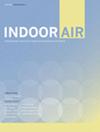结合室内实验和模型模拟评价具有表面光化学性质的室内HONO源
IF 4.3
2区 环境科学与生态学
Q1 CONSTRUCTION & BUILDING TECHNOLOGY
引用次数: 0
摘要
亚硝酸(HONO)是一种新兴的室内污染物,可对健康产生不利影响。室内HONO的化学生成归因于NO2非均相反应,并且通过实验室和模型模拟研究广泛评估了源强度。基于室内HONO积累与可见光辐射的相关性分析,最近提出了表面硝酸盐光解作为室内HONO源。然而,目前既没有对所提出的机制进行实验验证,也没有对源强度进行表征。在这项工作中,我们设计了一个室外光化学室(OPC)来模拟室内HONO积累,并建立了一个室内光化学模型(ICM)来计算室内HONO预算。室内HONO积累表现出明显的日变化,白天最大。只有使用这个室内HONO源,ICM才能再现OPC中确定的室内HONO预算。可见光下表面硝酸盐反应截面的增强占HONO源预算的主要部分(77.2%),且日差变化明显。ICM的成功鼓励我们在真实的室内环境中模拟HONO预算。在不同室内条件下,正午时地表硝酸盐光解产生HONO的速率在1.4 ~ 4.1 ppbv h-1之间。该室内HONO源日平均占客厅总化学源的42.4-52.7%,占厨房总化学源的4.7%,厨房以NO2非均相反应为主。本文章由计算机程序翻译,如有差异,请以英文原文为准。
Combining Chamber Experiments and Model Simulations to Evaluate an Indoor HONO Source with Surface Photochemical Properties
Nitrous acid (HONO) is an emerging indoor pollutant that can exert adverse health effects. The chemical production of indoor HONO has been attributed to NO2 heterogeneous reactions, and the source strength has been extensively evaluated via laboratory and model simulation studies. Photolysis of surface nitrate has recently been proposed as an indoor HONO source based on correlation analysis between indoor HONO accumulation and visible light radiation. However, neither experimental validation of the proposed mechanism nor source strength characterization is currently available. In this work, we designed an outdoor photochemical chamber (OPC) to simulate indoor HONO accumulation and established an indoor photochemical model (ICM) to calculate the indoor HONO budget. Indoor HONO accumulation revealed a distinct diel variation with a daytime maximum. Only with this indoor HONO source, the ICM reproduced the indoor HONO budget determined in the OPC. The enhanced reactive cross section of surface nitrate in visible light accounted for the major portion of the HONO source budget (77.2%) and the distinct diel variation. Success with the ICM encouraged us to simulate the HONO budget in real indoor environments. The calculated HONO production rates from surface nitrate photolysis at noon ranged from 1.4 to 4.1 ppbv h-1 under different indoor scenarios. On a daily average, this indoor HONO source contributed 42.4–52.7% to the total chemical sources in the living room but only contributed 4.7% to that in the kitchen, where NO2 heterogeneous reactions dominated.
求助全文
通过发布文献求助,成功后即可免费获取论文全文。
去求助
来源期刊

Indoor air
环境科学-工程:环境
CiteScore
10.80
自引率
10.30%
发文量
175
审稿时长
3 months
期刊介绍:
The quality of the environment within buildings is a topic of major importance for public health.
Indoor Air provides a location for reporting original research results in the broad area defined by the indoor environment of non-industrial buildings. An international journal with multidisciplinary content, Indoor Air publishes papers reflecting the broad categories of interest in this field: health effects; thermal comfort; monitoring and modelling; source characterization; ventilation and other environmental control techniques.
The research results present the basic information to allow designers, building owners, and operators to provide a healthy and comfortable environment for building occupants, as well as giving medical practitioners information on how to deal with illnesses related to the indoor environment.
 求助内容:
求助内容: 应助结果提醒方式:
应助结果提醒方式:


